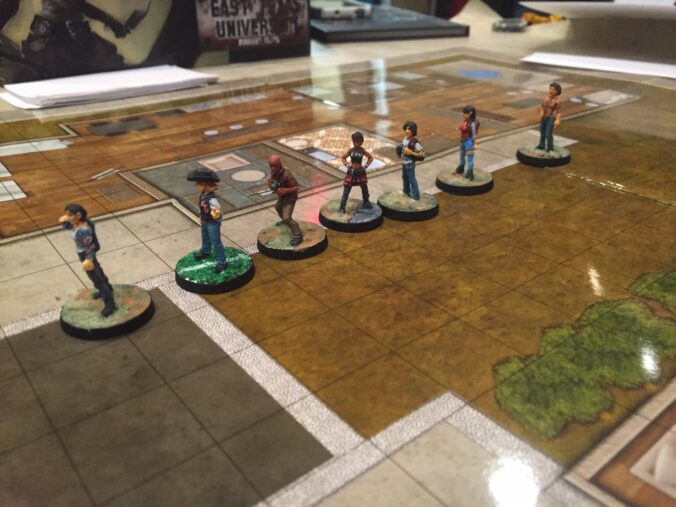As I mentioned on my prior post about Shane Hensley’s con game, during the game we had an area map from ETU on the table, but we ignored what was on the map and just used minis for general positioning and marching order.
At the very end he lifted up the ETU map and revealed a poster map of the final ‘boss fight’ scene; this was the only scene where we used a specific map. For most of the game it was theater of the mind action using the miniatures only for relative positions; he didn’t pull out minis for the bad guys until the final scene.
I personally like this technique since I find Theater of the Mind to be very immersive, though for tactical or ‘boss fight’ scenes where there is a lot going on in the environment and it’s hard to keep track of all characters movements and locations, I do see the benefit of miniatures.
Shane used the time-old technique of establishing marching order by use of miniatures. This came in handy with an encounter with the sewers where the first PCs in line were first to encounter some traps and bad guys. This worked well.
The way Shane managed tracking conditions on miniatures was not exactly like I expected. One of the mantras in Savage Worlds is that you don’t track hit points — characters are either ‘up, down or off the table.’ In the games I’ve played in or run, the way we’ve implemented this was this:
- Up = Character is not shaken and has no wounds
- Down = Character is shaken (wounds were tracked by players or the GM on a note or by tokens placed next to the mini)
- Off The Table = Character is incapacited
However, at least in this particular con game, here’s how Shane ran things:
- Up = Character is not shaken and has no wounds
- Up with Status Markers = Character is shaken and/or has wounds
- Down = Character is Incapacitated
Why did Shane run it this way? I can’t say for sure, but here are some ideas:
- Enemies were primarily college students who had been bewitched and transformed into monsters (Orcs). We were aiming to incapacitate, not kill, the enemy. So was helpful to have the minis there when they transformed back into students.
- The combat was crowded, not leaving much room for mins to be down where they would take up 2+ squares.
- Maybe this really is how most people run Savage Worlds miniatures these days and I just missed it!

Shaken status marker (normally completely under the mini, but I moved the mini so you can see the marker)
I’d love to hear any feedback on how you manage miniatures’ status during a game!






I break out minis for the baddies for most encounters. Although it’s often figure flats or generic placeholders like Bag o’ Zombies. Trying to get truly representative figures for every encounter would be pricey and time consuming.
I bought a set of Alea Tools before the official Savage Worlds markers became available, and I make heavy use of them.
http://www.aleatools.com/
For maps it’s usually just rough sketches on a Chessex battle mat.
I think Shane did such a compelling job of describing the scenarios, that strategy wasn’t necessary for most of the adventure. It was great, and Stan, I think your way of running adventures is very similar. Only the last fight needed any sort of map, because how and where the characters were played an important part of the final scene. Very much like 1e and 2e adventures. IMO.